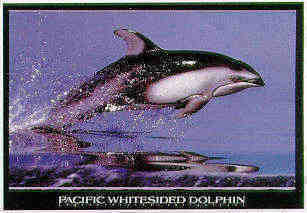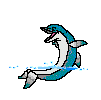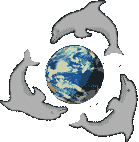



 On average, Pacific white-sided dolphins live 25-35 years in the wild. Pacific white-sided dolphins ride waves of Vessels. Pacific whited-sided dolphins hear and even "see" in the dark waters that mean they have sensory process called echolocation. This dolphin is some times called the "hook-finned porpoise" becuase of its distintive dorsal fin. These dolphin live in the temperate waters of the Pacific Ocean, from the coasts between North America and Asia. Pacific white-sided dolphins have been captured for aquariums and amusement parks for the past 25 years, until 1993 when the practice was banned due to the fame of the movie "Free Willy." They have suffered greatly in these artificial environments, never breeding, and experiencing a 70% mortality rate.
On average, Pacific white-sided dolphins live 25-35 years in the wild. Pacific white-sided dolphins ride waves of Vessels. Pacific whited-sided dolphins hear and even "see" in the dark waters that mean they have sensory process called echolocation. This dolphin is some times called the "hook-finned porpoise" becuase of its distintive dorsal fin. These dolphin live in the temperate waters of the Pacific Ocean, from the coasts between North America and Asia. Pacific white-sided dolphins have been captured for aquariums and amusement parks for the past 25 years, until 1993 when the practice was banned due to the fame of the movie "Free Willy." They have suffered greatly in these artificial environments, never breeding, and experiencing a 70% mortality rate.

 The greek name, for the Bottlenose Dolphin, is "xithemonas". That means guardian, since it is known to guide other dolphins and humans to safety. There are two kinds coastal and offshore. Offshore, they often congrate in grops of more than 25, sometimes reaching into hundreds. Coastal bottlenose dolphins usually travel in groups of less than ten. Scientists have yet to determine the combined total population of the bottlenose species because they are found in most oceans around the world. The bottlenose dolphin's brain is more complexed than the humans in some ways. But just like humans they have disadvantages. In 1987, about 750 bottlenose dolphins where washed a shore and many dying in the sea uncounted. In 1990, in the Gulf of Mexico, there was a "die off" killing about 800 dolphins. This is more likely to be the dolphin that loves to play around alot. This kind was in TV shows and movies like Flipper and many others, too.
The greek name, for the Bottlenose Dolphin, is "xithemonas". That means guardian, since it is known to guide other dolphins and humans to safety. There are two kinds coastal and offshore. Offshore, they often congrate in grops of more than 25, sometimes reaching into hundreds. Coastal bottlenose dolphins usually travel in groups of less than ten. Scientists have yet to determine the combined total population of the bottlenose species because they are found in most oceans around the world. The bottlenose dolphin's brain is more complexed than the humans in some ways. But just like humans they have disadvantages. In 1987, about 750 bottlenose dolphins where washed a shore and many dying in the sea uncounted. In 1990, in the Gulf of Mexico, there was a "die off" killing about 800 dolphins. This is more likely to be the dolphin that loves to play around alot. This kind was in TV shows and movies like Flipper and many others, too.
 East Spinner dolphin lives in the Eastern Tropical Pacific Ocean. They travel in hunting herds with yellowfin tuna. Tuna fishery use dolphin herds to get schools of yellowfin tuna. And as a result of that dolphins are often caught in nets and die. The greek name for this dolphin is "prostatis", or protector, since the mothers and others guard their young in the herd. They have declared "depleted" because of the large-scale losses from the tuna industry.
East Spinner dolphin lives in the Eastern Tropical Pacific Ocean. They travel in hunting herds with yellowfin tuna. Tuna fishery use dolphin herds to get schools of yellowfin tuna. And as a result of that dolphins are often caught in nets and die. The greek name for this dolphin is "prostatis", or protector, since the mothers and others guard their young in the herd. They have declared "depleted" because of the large-scale losses from the tuna industry.


Questions/Answers|Help|Dolphins Pictures|Arion|Animals
